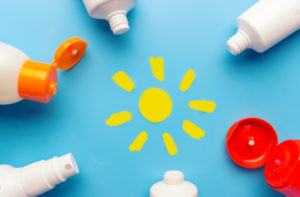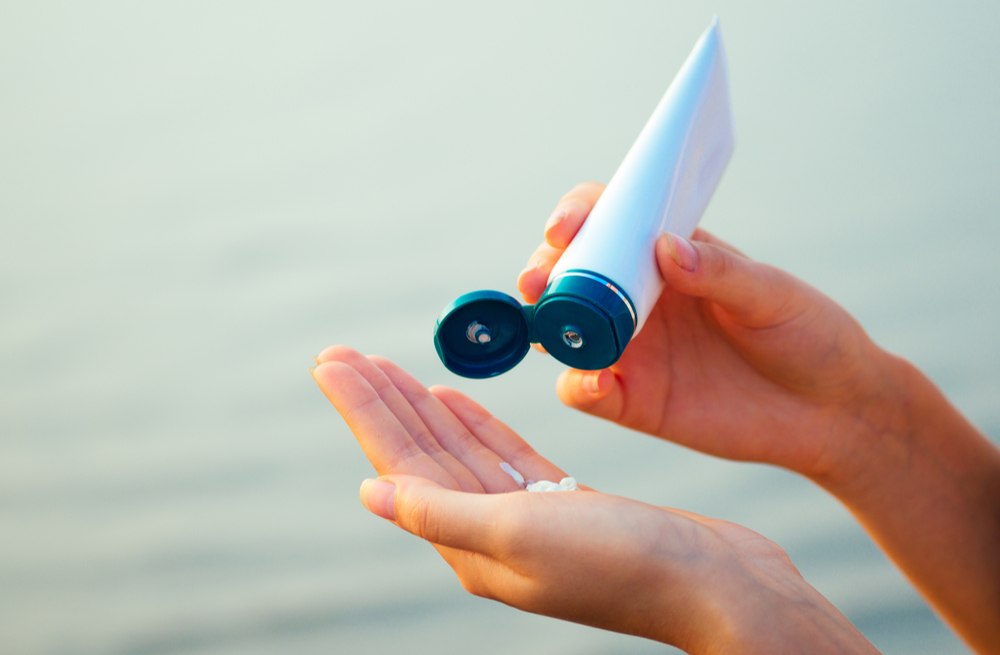As we emerge from the quarantine, many of us will look for ways to keep our social distance but still interact with the outside world. Of course, during the summer months, this means being outdoors. Whether you decide to go to the beach, pool, or for a hike, you will most likely bring some sunscreen with you. But, is sunscreen really safe? Does sunscreen decrease your chances of skin cancer? And what about all of the chemicals found in sunscreen: are they harmful? In this post, I will try to answer these questions with what the latest research says about sunscreen to help you make an informed decision.
The use of sunscreen possibly dates back to early Egyptians who used rice bran extracts, jasmine, and lupine extracts to absorb the sun’s strong rays. These chemicals are still used today in some modern sunscreen products. In the 1930s, modern sunscreen products began to gain popularity. L’Oreal produced the earliest and most effective product in 1936. In the 1940s, an American pharmacist would patent a sunscreen product that eventually became the Coppertone brand. Today, millions of people buy sunscreen each year spending billions of dollars on a product that they possibly do not know much about.
Does sunscreen decrease your chances of skin cancer?
Over 3 million people will be diagnosed with skin cancer this year. Most of these cases will not be fatal, but will require surgical removal of the cancerous lesion. Melanoma makes up the most fatal type of skin cancer with over 91,000 people diagnosed with melanoma annually and 9,000 deaths. Sun exposure appears to play a role with melanoma cases but a clear causative factor is not known. Namely, this is because melanoma often appears in areas not daily exposed to sunlight.
It is well known that UVA and UVB rays can lead to melanoma. It is also well understood that the number of sunburns, indoor tanning, and those living in more Northern cities are all risk factors that elevate your chances of melanoma. What is interesting is those that are exposed to sunlight on a daily basis, like an outside worker, and those who live in more southern or sunnier cities, are less likely to develop melanoma than those that work indoors in less sunny locations. It is hypothesized that Vitamin D may play an important protective role in skin cancer prevention and those who regularly see sunlight produce much more Vitamin D than those who don’t.
 So what about sunscreen? Does it decrease your chances of skin cancer? The research is not conclusive. It is known that sunscreen blocks the production of Vitamin D and that this may lower its cancer protection and place you at a greater risk of skin cancer. Likewise, the majority of sunscreens do not block UVA sun rays. These are highly correlated with skin cancer growth. Most sunscreens only block UVB rays, the rays that cause your skin to burn. So while we think we are protected because of the lack of a sunburn from the UVB rays, the UVA rays are wrecking the DNA of the skin cells, resulting in the formation of skin cancer. In 2019, the FDA promoted a bill that would require sunscreens to provide UVA protection. This same bill would require SPFs to be below 65. This is because the higher the SPF, the more UVB rays are blocked allowing the more damaging UVA rays to be allowed through. This means that the higher the SPF, the greater the potential long-term damage to your skin. Unfortunately, this bill was shut down in late 2019, but there are hopes it will be resubmitted later this year.
So what about sunscreen? Does it decrease your chances of skin cancer? The research is not conclusive. It is known that sunscreen blocks the production of Vitamin D and that this may lower its cancer protection and place you at a greater risk of skin cancer. Likewise, the majority of sunscreens do not block UVA sun rays. These are highly correlated with skin cancer growth. Most sunscreens only block UVB rays, the rays that cause your skin to burn. So while we think we are protected because of the lack of a sunburn from the UVB rays, the UVA rays are wrecking the DNA of the skin cells, resulting in the formation of skin cancer. In 2019, the FDA promoted a bill that would require sunscreens to provide UVA protection. This same bill would require SPFs to be below 65. This is because the higher the SPF, the more UVB rays are blocked allowing the more damaging UVA rays to be allowed through. This means that the higher the SPF, the greater the potential long-term damage to your skin. Unfortunately, this bill was shut down in late 2019, but there are hopes it will be resubmitted later this year.
Are there harmful chemicals in sunscreen?
Active ingredients in sunscreens function as either mineral or chemical UV filters that keep harmful rays from the skin. Each uses a different mechanism for protecting skin and maintaining stability in sunlight. The most common sunscreens contain chemical filters. These products typically include a combination of two to six of the following active ingredients: oxybenzone, avobenzone, octisalate, octocrylene, homosalate, and octinoxate. Mineral sunscreens use zinc oxide and/or titanium dioxide. A handful of products combine zinc oxide with chemical filters.
In a report released earlier this year, the FDA found that many sunscreen ingredients are absorbed into the skin and they also could be detected in the blood, skin tissue layers, and breast milk, weeks after their initial application. The FDA has only labeled two ingredients as safe, zinc oxide and titanium oxide, and most of the others as unknown or possibly safe. They have labeled oxybenzone as the most troublesome ingredient. It is reported that this ingredient has a high causative factor in skin reactions and endocrine disruption.
Endocrine disruption occurs with oxybenzone, as the ingredient acts as a weak estrogen hormone and dangerously reduces the testosterone production in males and children of both sexes. This chemical is also reported to reduce sperm count, alter thyroid hormones, and to increase a woman’s chances of having endometriosis. The CDC has reported that nearly 96 percent of Americans will test positive for elevated oxybenzone levels and those that regularly use sunscreen show the highest levels of all subgroups. Oxybenzone is also commonly found in cosmetics. I would highly recommend that everyone avoid products containing this harmful product.
How best to protect yourself from the sun:
Limited daily exposure
A few minutes in the sun each day has the potential to increase your Vitamin D levels. Vitamin D has been shown to help prevent skin cancer. If you can plan your activities early in the morning and/or late in the evening, the benefits of sun exposure are maximized while limiting the more damaging rays of midday.
Cover up with clothing
The use of hats, pants, shorts, and shirts are the best protection against the sun’s harmful UV rays. Clothing offers a chemical-free way of providing long-lasting protection. Look for light colors made of lightweight material that breathes in the air.
Wear sunglasses
Polarized sunglasses are helpful to protect the eyes from the sun’s UV rays. This is essential to prevent cataracts, a condition of the eye lens that can lead to poor vision and blindness.
Wear sunscreen
- Find a sunscreen with zinc oxide and void of oxybenzone.
- Apply heavily and often.
- Use a broad-spectrum sunscreen with an SPF of 15-50 that blocks both UVA and UVB rays. Any sunscreen with an SPF greater than 50 can lead to a false sense of security and prolonged exposure to the sun.
- Look for sunscreen by itself and not combined with a bug repellent.
- Do not use sunscreen sprays. Most sunscreen ingredients should never be inhaled and sprays often lead to uneven coverage leaving some areas of the skin under-protected.
If you have any questions about your sunscreen, please feel free to ask. We are more than happy to help you in every aspect of your life to become healthier than you have ever been.

Daryl C. Rich, D.C., C.S.C.S.






